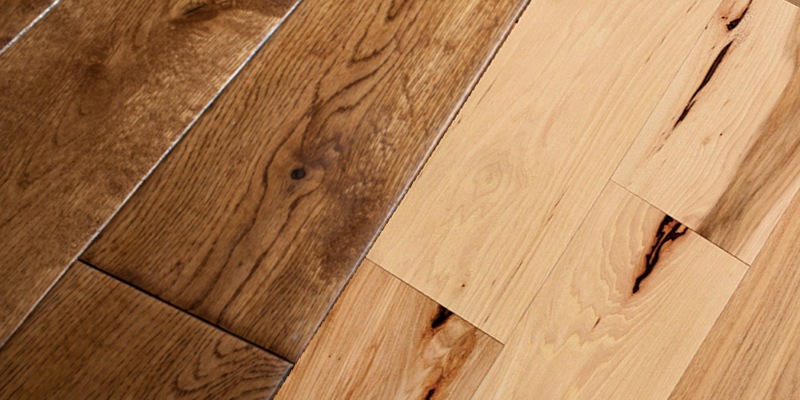
Wood floors come in two main types: prefinished and unfinished. Each has its own good points and not-so-good points, so it’s important to learn about both before deciding which one is right for your home.
Advantages of Unfinished Wood Flooring:
We label unfinished wood flooring as such because it lacks a finish upon installation, resembling the wood’s natural state. After placing the floor, subsequent steps like sanding, sealing, and applying a protective coat occur, earning it the term ‘site-finished flooring.’ This type is more common among professionals than regular buyers. Advantages of unfinished wood flooring include:
- It looks very even and smooth.
- You can make different designs on it, like patterns and colors.
- You have a lot of choices for colors and sheen.
- It looks like one big smooth surface when it’s done.

More Design Choices: It’s easier to do creative designs on unfinished floors, like putting in different types of wood or making special patterns. Even if the designs are different, they still feel smooth because they’re sanded down to be flat. This is harder to do with prefinished floors because they have small grooves between the boards and they’re not sanded after they’re put in.

Different Colors: After the floor is sanded, you can change its color with a special stain. Stains come in many colors and you can even mix them to make new colors. This is useful if you want the floor to match your furniture or other parts of your house. But remember, some types of wood take stains better than others.

Disadvantages of Unfinished Wood Flooring:
There are two main problems with unfinished wood flooring:
- It takes more time to finish the floor because of sanding and sealing.
- If it’s not done right, it can be messy and create dust.
Takes Longer: After the floor is put in, it needs to be sanded and finished. This takes a lot of extra time, usually a few more days. But it’s worth it to get the look you want. Dust Problem: Sanding wood floors makes a lot of dust. Even though there are ways to control the dust, it can still be a bit messy. But if you want a clean and neat installation, it’s a good idea to choose a method that reduces dust.
Advantages of Prefinished Wood Flooring:
Any flooring that has all its finish coats put on before it’s installed is called “prefinished flooring.” Because you can buy prefinished flooring easily, there are many different types to choose from. Here’s why prefinished wood flooring can be a good choice:
- No need to sand or finish it after it’s installed.
- The finish is put on in a factory, so it’s very controlled.
- Some kinds have a super strong finish that lasts a long time.
No Sanding Needed: With prefinished floors, all the finishing work is already done before the floor is put in. This means you don’t have to sand it or put on a finish afterwards. This saves time and keeps the mess down, although there might still be a bit of dust.
Controlled Finish: The finish is added to the wood in a factory, where everything is controlled. This helps the finish look really good and smooth. It’s especially useful if you want the floor to be a little shiny.
Strong Finish Options: Some prefinished floors have very tough finishes that can last a long time. These finishes are better than what you usually get with site-finished floors. But remember, these stronger finishes might cost more.
Disadvantages of Prefinished Wood Flooring
Limited Customization: Prefinished wood flooring comes with a set finish, so you can’t customize the color or look as easily as you can with unfinished flooring that allows for staining and design changes.
Difficult Repairs: If a prefinished floor gets damaged or scratched, repairing it can be more challenging because you have to match the original finish and texture.
Transition Issues: Transitioning between rooms or to different types of flooring can be trickier with prefinished floors due to the beveled edges and fixed finish, making it harder to achieve a seamless transition.
Visible Seams: Prefinished floors often have beveled edges that create seams between the boards, which can collect dirt and debris over time and be harder to clean than the smooth surface of unfinished floors.

Remember, if you’re ever unsure about which kind of flooring to choose, you can always ask an expert for advice. They can help you decide what’s best for your home.
